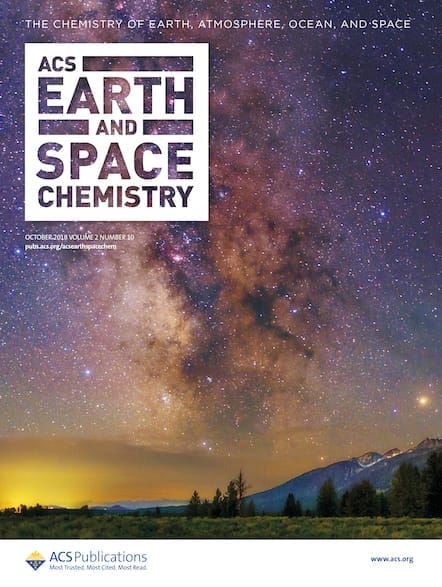The excitement around ACS Earth and Space Chemistry has only grown since the journal was announced last year under the leadership of Editor-in-Chief Joel D. Blum. Now we’re proud to announce a trio of Associate Editors have joined the journal, each bringing their own unique expertise. Meet the Associate Editors joining the ACS Earth and […]

The excitement around ACS Earth and Space Chemistry has only grown since the journal was announced last year under the leadership of Editor-in-Chief Joel D. Blum. Now we’re proud to announce a trio of Associate Editors have joined the journal, each bringing their own unique expertise.
Meet the Associate Editors joining the ACS Earth and Space Chemistry team:
***
Eric Herbst, Commonwealth Professor in the Departments of Chemistry, Astronomy, and Physics, University of Virginia
What do you hope to bring to your journal?
As someone knowledgeable about both chemistry and astronomy, I hope to show more chemists about how interesting astrochemistry is, and how astronomy can help us to understand chemistry better by providing sources in the universe that illustrate molecules and chemical reactions quite exotic compared with terrestrial chemistry.
Describe your current research.
I am interested mainly in the organic chemistry that occurs during the production of new stars and their planetary systems, which are formed in so-called interstellar clouds via a complex evolutionary process. One goal of this research is to understand the inventory of organic molecules present at the creation of earth-like planets.
What are the major challenges facing your field today?
The major challenge is not a scientific one, although there are many areas of astrochemistry that are incompletely understood. Rather, the problem is a lack of funding at the federal level to support individual investigators in this interdisciplinary science. This lack of funding is occurring during a period of rapid growth in the subject in European and Asian countries, where funding is much more readily available than in the US.
***
Chongxuan Liu, Chief Scientist at US Department of Energy, Pacific Northwest National Laboratory
What do you hope to bring to your journal?
I bring my expertise in low-temperature geochemistry, biogeochemistry, and multi-scale reactive transport.
Describe your current research.
My group is investigating hydro-biogeochemical dynamics of elements in groundwater and surface water interaction zones with a goal to develop predictive knowledge and models for describing coupled hydrological, geochemical, and biogeochemical processes of contaminants, organic carbon, nutrients, and colloidal particles in natural and engineered environments.
One of the major challenges in the fields of quantitative geochemistry, biogeochemistry, and reactive transport of elements is the heterogeneity of reactive transport properties and multiscale complex behaviors of reaction kinetics in natural environments.
***
V. Faye McNeill, Associate Professor, Department of Chemical Engineering, Columbia University
What do you hope to bring to your journal?
I am very excited to be part of the founding editorial team at ACS Earth & Space Chemistry. I look forward to working with the other editors to build the journal and make it a high-impact name in atmospheric chemistry publications. I bring ten years of editorial experience and broad expertise in atmospheric chemistry to the journal.
Describe your current research.
My research is in atmospheric chemistry and climate, with a focus on multiphase processes involving atmospheric aerosols and ice in the environment. My group performs laboratory, theoretical, and modeling studies.
What are the major challenges facing your field today?
The field of atmospheric chemistry is central to air quality and climate. In the next decade our field will be instrumental in addressing the air quality crises in China and India, and helping the world reach international climate goals. These policy challenges exist against a backdrop of scientific complexity, especially when it comes to atmospheric aerosols (particulate matter), which result from a combination of natural and anthropogenic emissions and in situ chemical and physical processing. Constraining the sources of atmospheric particulate matter, especially its organic component, is one of the issues at the cutting edge of atmospheric chemistry research.
Do you have a recent paper in an ACS journal that you’d like to highlight?
Observation of Organic Molecules at the Aerosol Surface
J. Phys. Chem. Lett., 2016, 7 (12), pp 2294–2297
DOI: 10.1021/acs.jpclett.6b00872
Aqueous Organic Chemistry in the Atmosphere: Sources and Chemical Processing of Organic Aerosols
Environ. Sci. Technol., 2015, 49 (3), pp 1237–1244
DOI: 10.1021/es5043707
***
Check Out the First Articles Published in ACS Earth and Space Chemistry
Thermochemistry of HIO2 Species and Reactivity of Iodous Acid with OH Radical: A Computational Study
ACS Earth Space Chem., Article ASAP
DOI: 10.1021/acsearthspacechem.6b00010
***
Pathways to Meteoritic Glycine and Methylamine
ACS Earth Space Chem., Article ASAP
DOI: 10.1021/acsearthspacechem.6b00014
***
Nitrogen Isotopic Fractionation in Ammonia during Adsorption on Silicate Surfaces
ACS Earth Space Chem., Article ASAP
DOI: 10.1021/acsearthspacechem.6b00006
***
Damköhler Number Input to Transport-Limited Chemical Weathering Calculations
ACS Earth Space Chem., Article ASAP
DOI: 10.1021/acsearthspacechem.6b00007
***
Electron-Induced Synthesis of Formamide in Condensed Mixtures of Carbon Monoxide and Ammonia
ACS Earth Space Chem., Article ASAP
DOI: 10.1021/acsearthspacechem.6b00011
***
Composition and Evolution of Frozen Chloride Brines under the Surface Conditions of Europa
ACS Earth Space Chem., Article ASAP
DOI: 10.1021/acsearthspacechem.6b00003
***
Follow ACS Earth and Space Chemistry on Twitter at @ACSEarthSpace.
